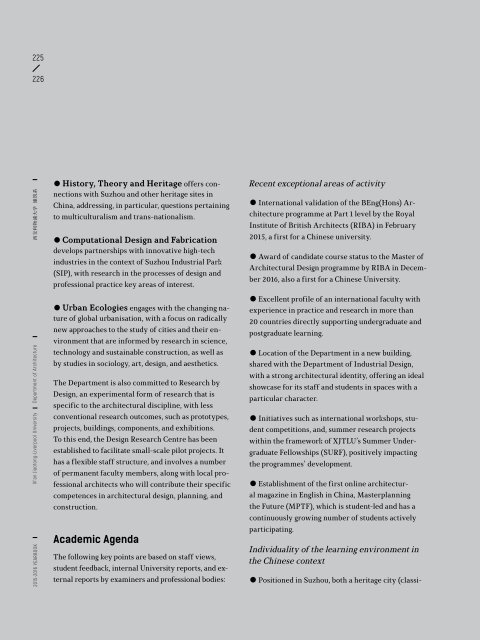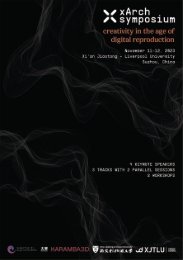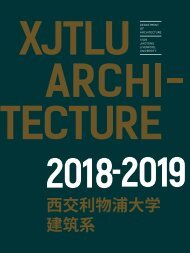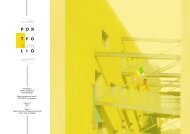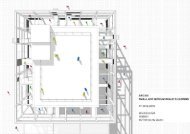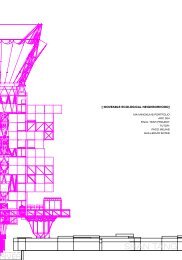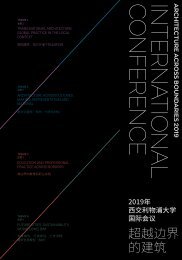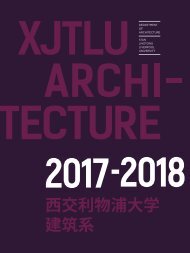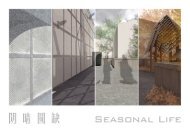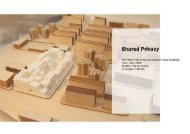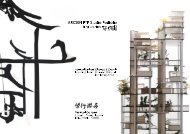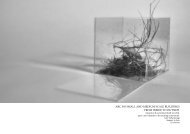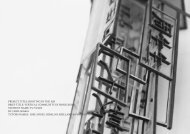YEARBOOK 2015 - 2016 | XJTLU DEPARTMENT OF ARCHITECTURE
The third edition of the yearbook of the Department of Architecture at Xi'an Jiaotong-Liverpool University presents student works created during the academic year 2015 - 2016. The yearbook exemplifies the new model for Chinese architectural education for which the department was commended by the Royal Institute of British Architects (RIBA) in their validation report for the Bachelor in Architecture. It is thus also a showcase of the creative culture that has guided our students in taking first steps to successful international careers as responsible and creative architectural designers.
The third edition of the yearbook of the Department of Architecture at Xi'an Jiaotong-Liverpool University presents student works created during the academic year 2015 - 2016. The yearbook exemplifies the new model for Chinese architectural education for which the department was commended by the Royal Institute of British Architects (RIBA) in their validation report for the Bachelor in Architecture. It is thus also a showcase of the creative culture that has guided our students in taking first steps to successful international careers as responsible and creative architectural designers.
You also want an ePaper? Increase the reach of your titles
YUMPU automatically turns print PDFs into web optimized ePapers that Google loves.
225<br />
226<br />
<strong>2015</strong>-<strong>2016</strong> <strong>YEARBOOK</strong> Xi’an Jiaotong-Liverpool University Department of Architecture 西 交 利 物 浦 大 学 建 筑 系<br />
● History, Theory and Heritage offers connections<br />
with Suzhou and other heritage sites in<br />
China, addressing, in particular, questions pertaining<br />
to multiculturalism and trans-nationalism.<br />
● Computational Design and Fabrication<br />
develops partnerships with innovative high-tech<br />
industries in the context of Suzhou Industrial Park<br />
(SIP), with research in the processes of design and<br />
professional practice key areas of interest.<br />
● Urban Ecologies engages with the changing nature<br />
of global urbanisation, with a focus on radically<br />
new approaches to the study of cities and their environment<br />
that are informed by research in science,<br />
technology and sustainable construction, as well as<br />
by studies in sociology, art, design, and aesthetics.<br />
The Department is also committed to Research by<br />
Design, an experimental form of research that is<br />
specific to the architectural discipline, with less<br />
conventional research outcomes, such as prototypes,<br />
projects, buildings, components, and exhibitions.<br />
To this end, the Design Research Centre has been<br />
established to facilitate small-scale pilot projects. It<br />
has a flexible staff structure, and involves a number<br />
of permanent faculty members, along with local professional<br />
architects who will contribute their specific<br />
competences in architectural design, planning, and<br />
construction.<br />
Academic Agenda<br />
The following key points are based on staff views,<br />
student feedback, internal University reports, and external<br />
reports by examiners and professional bodies:<br />
Recent exceptional areas of activity<br />
● International validation of the BEng(Hons) Architecture<br />
programme at Part 1 level by the Royal<br />
Institute of British Architects (RIBA) in February<br />
<strong>2015</strong>, a first for a Chinese university.<br />
● Award of candidate course status to the Master of<br />
Architectural Design programme by RIBA in December<br />
<strong>2016</strong>, also a first for a Chinese University.<br />
● Excellent profile of an international faculty with<br />
experience in practice and research in more than<br />
20 countries directly supporting undergraduate and<br />
postgraduate learning.<br />
● Location of the Department in a new building,<br />
shared with the Department of Industrial Design,<br />
with a strong architectural identity, offering an ideal<br />
showcase for its staff and students in spaces with a<br />
particular character.<br />
● Initiatives such as international workshops, student<br />
competitions, and, summer research projects<br />
within the framework of <strong>XJTLU</strong>’s Summer Undergraduate<br />
Fellowships (SURF), positively impacting<br />
the programmes’ development.<br />
● Establishment of the first online architectural<br />
magazine in English in China, Masterplanning<br />
the Future (MPTF), which is student-led and has a<br />
continuously growing number of students actively<br />
participating.<br />
Individuality of the learning environment in<br />
the Chinese context<br />
● Positioned in Suzhou, both a heritage city (classical<br />
gardens recognised as UNESCO World Heritage<br />
Sites) and an extremely dynamic new city, now the<br />
fourth largest concentration of economic activity in<br />
China in terms of GDP.<br />
● Unique offering of undergraduate and postgraduate<br />
programmes in English in China, taught by<br />
international educators.<br />
● Excellent resources on a new campus, open to the<br />
vibrant life of one of China's flagship development<br />
projects, the Suzhou Industrial Park (SIP), within<br />
which the University and more than 100 Fortune 500<br />
companies operate, offering a high quality of life.<br />
● Excellent building resources supporting a vibrant<br />
studio culture, with dedicated spaces for design studios,<br />
reviews, and physical modelling, as well as for a<br />
materials library.<br />
● Recruitment of students from amongst the top 5%<br />
of Chinese high school graduates, and a progressive<br />
increase of international students.<br />
Differences between Bachelor and Master<br />
degrees<br />
● BEng programme: provides a clear sequence of<br />
design studios with the gradual introduction of ideas<br />
and skills, with a focus on the attainment of personal<br />
and professional confidence in order to take advantage<br />
of practice experience.<br />
● MArchDes programme: fosters student autonomy<br />
and responsibility in pursuing individual interests<br />
in view of future professional career development<br />
opportunities, with the second year framed as a “research<br />
by design” year.<br />
● MArchDes programme: connection with <strong>XJTLU</strong>’s<br />
Master programmes in Urban Planning and Urban<br />
Design (with the Urban Planning and Design Department)<br />
in year one creates unique possibilities for<br />
interdisciplinary design research.<br />
Relevance to professional practice<br />
● Design studio themes are strongly connected with<br />
real-world problems and necessities in China and<br />
beyond; lecture courses and coursework are related<br />
to contemporary issues and current concerns.<br />
● Practicing architects in Suzhou and Shanghai<br />
contribute as part-time tutors and visiting critics,<br />
and present guest lectures, lead site visits, and offer<br />
internships for students.<br />
● Establishment of a Design Research Centre which<br />
seeks to actively involve staff, students and local<br />
practicing architects in the development of pilot<br />
projects.<br />
● Graduates work in top architectural offices, and<br />
assist in strengthening the connections of the Department<br />
to local practice.<br />
Creative criteria delivering course content<br />
● Innovative learning environment that fosters<br />
independent, creative and responsible designers with<br />
a thoughtful, research-led and imaginative approach<br />
to place-making.<br />
● Close collaboration with the two other Departments<br />
of the Built Environment Cluster (Urban<br />
Planning & Design and Civil Engineering), as well<br />
as with the Department of Industrial Design (with


